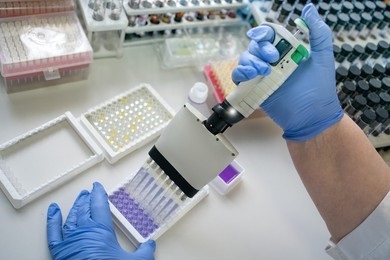Soil enzymes include soil accumulation enzymes, including free enzymes, intracellular enzymes, and extracellular enzymes, mainly from soil microorganisms, plant root secretions, and enzymes released during the decomposition of plant and animal residues, mainly involved in the biotransformation of substances and nutrient morphological transformation in the soil.

Enzymes are one of the most active organic components in soil fractions, and their activities not only reflect the exuberance of soil material-energy metabolism but also serve as an important indicator for evaluating soil fertility and ecological quality. In almost all ecosystem monitoring and research, soil enzyme activity is an essential measurement indicator.
Lifeasible uses spectrophotometric colorimetric analysis, fluorescence analysis, radioisotope analysis, and physical methods (titration), hydrodynamic voltammetry, etc. to achieve efficient and accurate detection of a wide range of soil enzymes. More than 20 types of soil enzymes can be detected, including soil urease, soil sucrase, soil cellulase, and soil dehydrogenase, to meet your different testing needs.
Some of the soil enzymes available for testing
| ID | Test indicators | ID | Test indicators |
| 1 | Invertase | 14 | α-glucosidase |
| 2 | Cellulase | 15 | β-glucosidase |
| 3 | Xylanase | 16 | β-xylanosidase |
| 4 | Fluorescein diacetate (FDA) hydrolysis | 17 | Phosphatase |
| 5 | Chitinase | 18 | phosphomonoesterases |
| 6 | Dehydrogenase | 19 | Arylsulfatase |
| 7 | Alkaline protease | 20 | Hydrogen peroxidase |
| 8 | Neutral protease | 21 | Amylase |
| 9 | Acid protease | 22 | Carbonic anhydrase (CA) |
| 10 | Peptidase | 23 | Acidic invertase |
| 11 | Urease | 24 | Nitrite reductase |
| 12 | Denitrification enzymes | 25 | Nitrate reductase |
| 13 | Methane monooxygenase (MMO) | 26 | Polyphenol oxidase (PPO) |
* Soil enzymes available for testing are continuously being updated.
The enzyme is mixed with a substrate and incubated to produce a colored product that produces a characteristic peak at a certain absorption wavelength. Lifeasible determines the activity of a specific enzyme by measuring the absorbance values of the set standard and the product with a spectrophotometer.
Compared to traditional methods, fluorescence analysis is a more powerful analytical tool that has flexibility high sensitivity (2 to 3 orders of magnitude higher than spectrophotometry), short-time consumption, and small sample size.
This method achieves effective mixing and convection of the sample solution by converting the substrate in the soil enzyme reaction and then mass transporting it to the electrode surface, thus Lifeasible for rapid detection of soil enzyme activity by electrochemical oxidation of PAP, and this method is more sensitive.
Lifeasible offers simple, fast, and low-cost methods, we can help you complete your project quickly, and we provide customized soil enzyme testing solutions for the different needs of our customers, please contact our staff for more information.
Lifeasible has established a one-stop service platform for plants. In addition to obtaining customized solutions for plant genetic engineering, customers can also conduct follow-up analysis and research on plants through our analysis platform. The analytical services we provide include but are not limited to the following:
Get Latest Lifeasible News and Updates Directly to Your Inbox
Adaptive Evolutionary Mechanism of Plants
February 28, 2025
Unraveling Cotton Development: Insights from Multi-Omics Studies
February 27, 2025